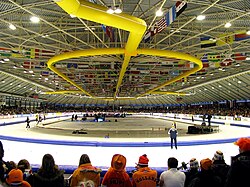Thialf

|
|
| Location | Pim Mulierlaan 1 Heerenveen, Netherlands |
|---|---|
| Coordinates | 52°56′19″N 5°56′31″E / 52.9386°N 5.94201°ECoordinates: 52°56′19″N 5°56′31″E / 52.9386°N 5.94201°E |
| Owner | Essent, Aegon, and the city of Heerenveen |
| Capacity | 12,500 seats |
| Surface | 15,000 m2 (big hall) 1800 m2 (small hall) |
| Construction | |
| Broke ground | 1966 |
| Opened | 14 October 1967 (outdoor) 17 November 1986 (indoor) |
| Renovated | 2001, 2004, 2015–16 |
| Architect | Alynia Architecten Harlingen bv |
| Tenants | |
| Heerenveen Flyers | |
Thialf is an ice arena in Heerenveen, Netherlands. The stadium is used for long track speed skating, short track speed skating, ice hockey, figure skating, and non-sports events. The outdoor rink was opened in 1967, and the indoor stadium was opened in 1986. Several world records were set in the indoor stadium. Annually, Thialf hosts two Speed Skating World Cup events. The arena has a capacity of 12,500 seats. Jan de Jong was the ice rink master at Thialf for many years.
Thialf is named after Thialfi, a character in Norse mythology, who was Thor's servant and had to race a giant.
The construction of the artificial outdoor ice rink was started in 1966 and it was opened on 14 October 1967 by Princess Christina of the Netherlands. It was the third 400m artificial ice rink in the Netherlands, after the Jaap Eden baan in Amsterdam and the IJsselstadion in Deventer. Several national and international tournaments were held in Thialf, but only one world record had been skated on the outdoor rink, by Andrea Schöne on the 5000 m in 1983.
The roofed stadium, which seats 12,500 people, opened on 17 November 1986, about a year after Sportforum Hohenschönhausen in Berlin, which was the first 400m indoor speed skating oval in the world. Thanks to the indoor conditions, allowing climate control, almost all world speed skating records were broken at Thialf in the first season. Since 1988 it has been overtaken as the "fastest ice in the world" by the high-altitude indoor rinks in Calgary and Salt Lake City, which have the additional benefit of low air pressure.
...
Wikipedia
